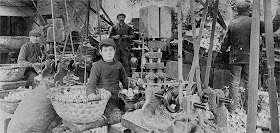This 19th century illustration is one that is commonly used in text books to describe the Industrial Revolution. It focuses on the child and women laborers at the time. Putting children to work was the best option for factory owners because they could learn tasks easily, as well as were obedient and respectful to their authorities. However, child labor became a big problem once it had became abused.
http://histclo.com/essay/war/war-ir01.html
Monday, February 23, 2015
In this picture, we see what seems to be a series of young girls working at a textile factory. Although rare, children would sometimes work up to 19 hours per day, having only a 1 hour break. It was common for children to work for 14 hours per day.
http://pixgood.com/the-industrial-revolution-child-labor-accidents.html
http://pixgood.com/the-industrial-revolution-child-labor-accidents.html
In this photo, we see children lining up outside a factory for food. During the Industrial Revolution, factory owners with child laborers would often pay their workers in food, shelter, and clothing instead of money. However, this "payment" was far below what was deserved.
http://www.leics.gov.uk/index/leisure_tourism/local_history/recordoffice/recordoffice_services/record_office_educational_services/record_office_education/record_office_educational_resources-8.htm
http://www.leics.gov.uk/index/leisure_tourism/local_history/recordoffice/recordoffice_services/record_office_educational_services/record_office_education/record_office_educational_resources-8.htm
Sunday, February 22, 2015
This is a photo of child laborers whom of which worked in the coal mines. These children worked in horrible conditions, often having to use large, heavy, and dangerous equipment while on the job. Sadly, a lot of accidents occurred while working, often causing kids to get injured, or even worse, killed.
http://www.victorianchildren.org/victorian-child-labor/
http://www.victorianchildren.org/victorian-child-labor/
This illustration depicts some of the work child laborers in the coal mine would do. Since children were smaller, they could maneuver around the mine easier and fit in areas adults could not, making them more preferable for the job.
http://ndla.no/en/node/88999?fag=71085
http://ndla.no/en/node/88999?fag=71085
This is image of a boy working a drilling machine. This proves the dangerous environments child laborers had to work in, which were unfit for children to be in due to the dangers they posed. The majority of the children working at the time were under 10 years of age, making it even worse.
https://www.english-heritage.org.uk/discover/explore/victorian/1780611/
https://www.english-heritage.org.uk/discover/explore/victorian/1780611/
This is a photo of child laborers who worked at a mill. By 1819, child labor laws were finally put into place where the minimum age of workers was 9 years old and they could only work up to 12 hours per day. By 1833, a law was passed that sent government inspectors to factories as overseers to make sure the child labor laws were being followed. Finally, by 1847, a law was passed by British parliament which limited children and women's work days to 10 hours.
http://histclo.com/act/work/cou/work-eng.html
http://histclo.com/act/work/cou/work-eng.html






